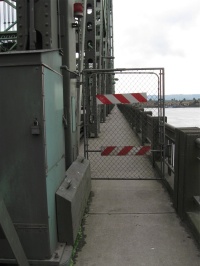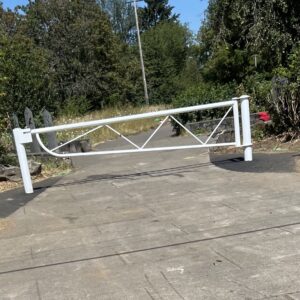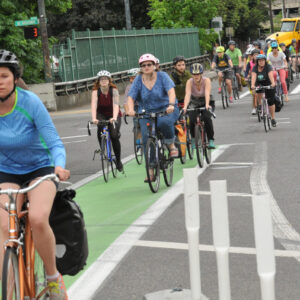[NOTE: Please see this major update to this story.]

yesterday evening.
(Photo: Todd Boulanger)
Last night, the gates on the sidewalk of the Interstate Bridge over the Columbia River between Portland and Vancouver malfunctioned, staying closed for over 30 minutes. People on bicycles trying to commute across the river were forced to either turn back or, in some cases, they rode onto I-5 to get around the gates.
According to Todd Boulanger, a former City of Vancouver Transportation Planner, the malfunction occurred at around 6:00 pm. He contacted us last night to share the news and an email he wrote to ODOT and transportation staff from the cities of Portland and Vancouver.
Here’s the email:
Dear ODOT Portland Region 1,
About 6Pm tonight the Interstate Bridge pedestrian / bike lift gates jammed shut in the ‘lift’ position for the trail (both sides) but not the roadway – as the road gates were open to car traffic. The gates were like this for over 30 minutes until the next bridge lift at 7PM. As commuter bicyclists turned around or jumped the gate (into the road) – there was little awareness or action (no warning signs or verbal direction over loudspeakers) by the ODOT bridge keepers. See photo.
Please send out a repair team to check on this dangerous malfunction.
Thank you,
Todd Boulanger
Vancouver, WA
Did anyone else experience this?
We’ll update this story if we hear any official response.






Thanks for reading.
BikePortland has served this community with independent community journalism since 2005. We rely on subscriptions from readers like you to survive. Your financial support is vital in keeping this valuable resource alive and well.
Please subscribe today to strengthen and expand our work.
A $3 billion bridge would fix that for sure.
Probably, but the governors appear to want to build the $10 billion bridge instead. Hopefully if that goes through it will also fix the problem. I’d settle for seismic refits to the existing bridge, more training for the operators, and rebuilt sidewalk gates.
The most effective training would be to replace human operators with an automated system with redundancy and secured remote centralized oversight, like the PBOT/ODOT traffic headquarters.
Probably be much cheaper too that the current system.
I disagree. Automated systems break, even with redundancy – the more parts in a system, the more likely something will fail. Efficiency is not the end-all, be-all. We need to make our systems *less* efficient, and put human beings back into them – simplify things. How often do loop detectors fail to see bikes? How often do pedestrian pushbuttons break? (more often than you think) When the traffic signals were on timers, you could always count on eventually getting a green.
I agree: automated systems fail.
The problem is that this story exists because the human component failed.
What’s worse is that most of our bike vs auto altercation stories can be boiled down to poor driver training. Training is given and is simply not retained or not valued enough to pay attention to in the first place.
Training or teaching is what you do to impart knowledge to a system (the human mind) that is not designed with that original purpose in mind. People are really good at socializing, fighting and “breeding” but paying attention 100% of the time to any task is seemingly impossible. What can we do re-engineer the human brain?
An automated system is purpose built for a task and its attention does not wander. Can it fail: yes. Failure modes can be designed for and mitigated. Human oversight of automated systems is common in litigious societies, such as ours, to provide the final back stop against rare mechanical failures.
We are surrounded by millions of mechanical, electrical and computerized devices that fail at rates of less than “five nines”. Our lives are made immeasurably easier (not so immeasurable: look at the Amish) by machines and automation.
Yet you define your awareness and opinion of them by one standard: traffic control devices.
Surely they can cause inconvenience when they fail but humans cause far greater grief and harm on a daily basis.
Employing people for the sake of employment or tradition is not logical and does not achieve any measurable goal other than employment.
Seismic retrofits won’t help that existing bridge.
Really? Because I read that a seismic retrofit of that bridge would cost less than the money already spent on planning its replacement.
It won’t make the sidewalks wider.
It won’t fix the malfunctioning gates.
It won’t add lanes.
Seismic upgrades are not a “sexy” project. Taxpayers see money spent, traffic snarled and then their commute is just as slow.
Same with the rail bridge fix to obviate the need for as many I-5 bridge lifts.
Was that an ODOT report, or a group opposed to the CRC?
I’ve heard similar claims for the Sellwood bridge project, a bridge which was structurally failing to begin with and was derated. Opposition reports don’t impress me.
I’d settle with segregated bicycle/pedestrian infrastructure with functional gates and proper one-way signage…
Boy howdy, I’d call someone to come pick me up before I’d even think about jumping into the road during rush hour.
This happens to me every now and then on the pedestrian path of the Steel Bridge. Someone is usually up in the office on top of the bridge, and sometimes I’ve been able to yell up there (after going up to the upper part of the bridge) and get them to open the darn gates.
I don’t know why they can automate these things to close, but not to necessarily open.
The cheapest solution would be to install a call box at each of the gates up to the control room so you can yell at the responsible person directly.
I would have been very tempted to leave a note:
“Fix this gate or it will be removed. Sincerly, Tax Paying Cyclist.”
Fines and tickets have much less harmful consequences than dicing with raging cagers on an interstate.
No reply to my note from ODOT yet.
Perhaps they are installing a bike detour sign now: bike detour, use 205 Bridge.
Hope not – a 20 mile detour might work for car drivers but not for bikes and peds. 🙁
“Automated systems break, even with redundancy – the more parts in a system, the more likely something will fail.” So true. The problem with the rest of you logic is that it fails to assert the fact that the Human part of this system contains millions of sub-parts thus making it infinitely more complex.
Also math fail: “common sense” strikes again.
10,000 parts in a hypothetical system all with an uptime rate of 99.999% works out to about 90% uptime or 10% failure rate.
Compare this to a 50/50 chance that the human in charge of a mechanical system is not paying attention.
One person by themselves is considered a failure mode waiting to happen; this is why for critical system uptime redundant automation is backed up by human oversight.
The real engineering problem comes when you over design a part so that it no longer fails. In not failing it causes associated/connected part failure. For example: designing a part too strong/rigid then forces excess vibrational energy to be transferred to other components that would have never failed alone when all parts were dissipating vibration evenly.
I imagine as long as there’s a draw bridge there we will have a live human manning the bridge. A call box at either end of the sidewalk span would be nice. Or even a posted phone for the bridge tender:
360.533.9359
Oh and I’d be very hesitant to take a lane here. I’d suggest backtracking to Delta Park Max station and grabbing a C-Tran #4 to cross the river.
You wouldn’t need to take a lane, you only need to go about 20′ to get around the gate. If there were 3 people you could do it with 3 bikes — wait for a 30 second gap in traffic, hand the bike over the concrete barrier, push it 20′ down the road, and hand it back over to person #3. Not too hard, much safer than trying to do it with only yourself.
Ted Buehler
It’s not legal to take the I-5 lanes between the south end of the OR 217 interchange and the north end of the I 205 Salmon Creek interchange.
If I had an extreme opening in traffic I might have thrown my bike over my shoulder and hopped around the gate quickly. Chances are I probably would have just road back to Taco Bell. lol
Just added a pair of wire snippers to me usual tool kit in my pannier – shhh
Todd — were you on the bridge? Did anyone consider just calling 911? Seems like a definite emergency situation if you’re stuck on a bridge for 1/2 hour with no safe exit, and no reason to expect the gates to open anytime soon. Or at least call the Vancouver WA nonemergency police #.
Ted Buehler
Note on the previous post — I thought the bicyclists were trapped between the two gates. Given that they were just blocked from crossing the river,
1) no need to call 911, and
2) much harder to get past the gates — you’d need to do the handoff past two gates. Or just take the lane.
It wouldn’t be hard to just take the lane going north at 6pm, as the right Kane moves pretty slw for the 20mph offramp for highway 14, and the bridge has a general downhill slope.
Ted Buehler
I have posted a major update to this story with response from ODOT here.